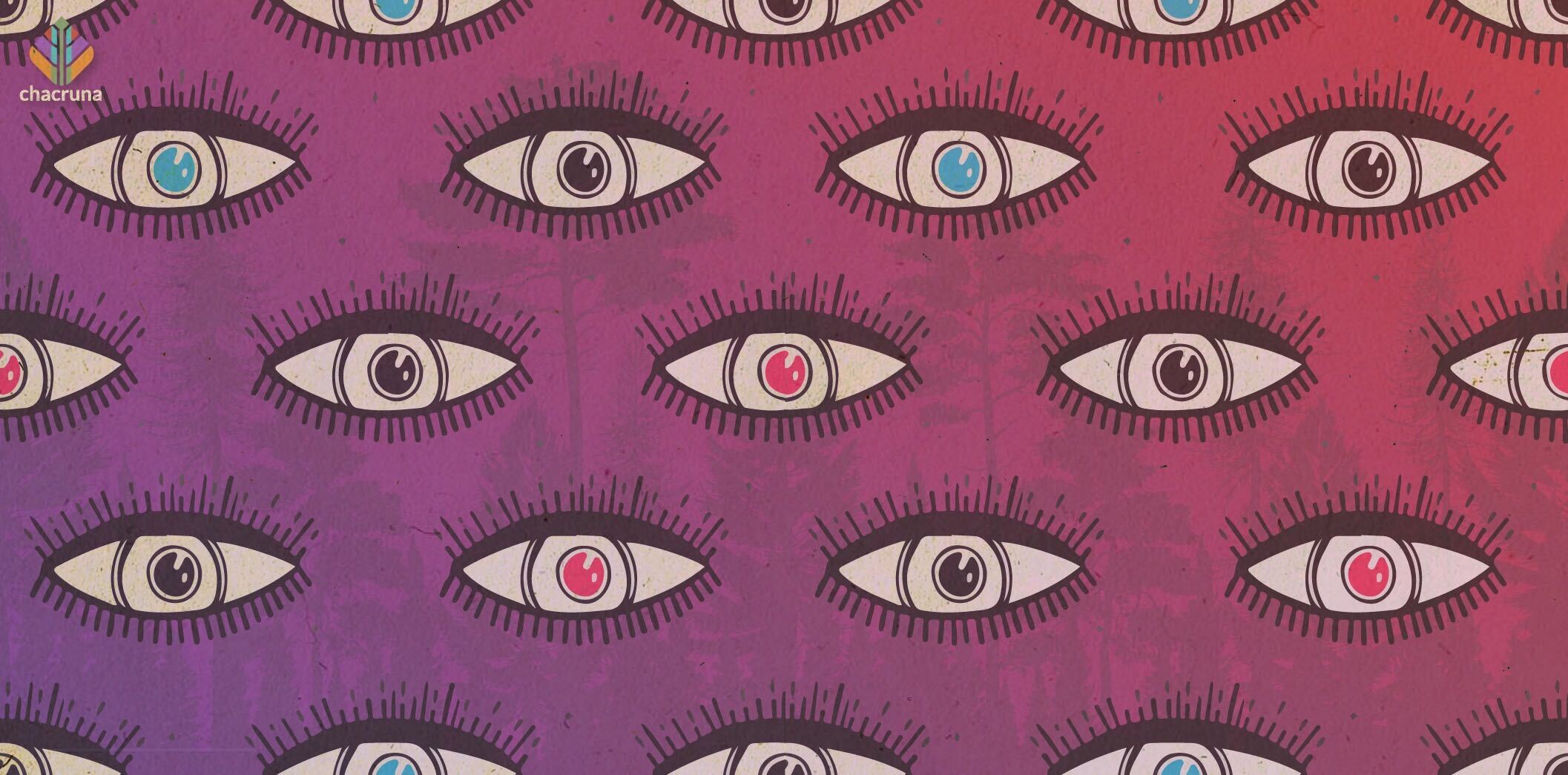- 2024 Begins with Trepidation in Psychedelic Medicine and Markets - January 26, 2024
- This is How Jurema, a DMT-Containing Tree, Helped the Pankararé People Recover Their Land in Brazil - December 29, 2023
- The Triumphant Comeback of Psychedelics - July 24, 2023
Annoyed by the endless conversation, a man in his sixties leaves the group, walks a short way down the dirt path and finds himself in the shade of a tree. Three hours ago, he took about 150 micrograms of LSD—a full, if not necessarily heroic, dose. His gaze is drawn upward, and he doubts what he sees. The tree is alive; too alive. Of course, every tree lives, he says to himself, but this is something else. There is no wind, yet a section of the trunk moves slowly and languidly, like a huge and decidedly feminine snake. The bark of the wood has geometric patterns of yellow, brown, and green. He recognizes it is a psychedelic vision, and rejoices at the chance to observe a tree as if seeing one for the first time.
After a few seconds, the giddy rapture passes. The snake-tree gradually transforms into a woman. Reality imposes itself brutally as the geometric designs coalesce into the print patterns on her blouse and the texture of denim shorts. The magic moment fades away: he is, in fact, facing a young woman who has climbed a tree, one of the traveling companions in the session in a rural compound near São Paulo. He laughs at himself, at the powerful but fleeting vision provided by the substance.

Join us at Sacred Plants in the Americas II
How can psychedelics have therapeutic potential—for example, in the treatment of depression—if they reproduce symptoms similar to those of serious pathologies?
What are these visions mediated by psychedelics, anyway? From what psychic mechanisms do they arise? How are they similar to or different from hallucinations produced by means other than drugs, or from psychiatric diseases, such as schizophrenia, or neurological disorders, such as certain forms of dementia? How can psychedelics have therapeutic potential—for example, in the treatment of depression—if they reproduce symptoms similar to those of serious pathologies?
Neuroscience does not yet have complete answers to these questions; however, it has taken decisive steps in the right direction. The International Hallucination Research Consortium (ICHR) has brought together scientific data on the subject from various perspectives, including pharmacology and functional imagery of the brain, as well as phenomenology, which is to say, reports of visions or hallucinations experienced by actual people.
It is beyond the scope of this article to go into the full details of the article in Schizophrenia Bulletin by Pantelis Leptourgos and collaborators, entitled “Hallucinations Under Psychedelics and in the Schizophrenia Spectrum: An Interdisciplinary and Multiscale Comparison.” The reader will have to settle for my superficial and incomplete summary, but I strongly recommend delving into the full study.
One similarity observed between psychedelic and psychiatric hallucinations is a reduction in the integrity and stability of functional brain networks, which results from a relaxation of simultaneous firing patterns by neurons in different brain areas associated with different states of arousal, such as sleep, wakefulness, attention, and introspection. In this regard, an important network that you will be hearing about a lot is the default mode network, or DMN. Linked to introspection, it is usually only active when other networks, those that direct attention towards the external world during the performance of motor tasks, are silenced. This relative exclusivity in brain function is referred to as “anti-correlation,” or “orthogonality,” and it has been observed to weaken during the emergence of hallucinations in schizophrenia, as well as with the use of some psychedelics.
Another similarity pointed out in the article is the attribution of what the authors call a “strong metaphysical meaning” to such visions or hallucinations. The voices heard by schizophrenics are perceived as real, external voices, not delusions fabricated by the subject. An undulating tree trunk covered with geometric designs presents itself in the psychedelic trip as the true feminine essence of the plant, although it was just a woman who climbed a tree.
Psychedelics boost the firing of neurons especially in the primary sensory cortex; whereas, in psychosis, hyper-activation affects associative brain networks.
There are some important differences, however. Psychedelics boost the firing of neurons especially in the primary sensory cortex; whereas, in psychosis, hyper-activation affects associative brain networks. In the case of psychedelics, these alterations are transient, disappearing with the intervention of rational thoughts or when the drug’s effect passes. In schizophrenia, such manifestations are chronic.

Discover Indigenous Reciprocity Iniciative of the Americas
The first study to show activation of the primary visual cortex by a psychedelic substance—in this case, ayahuasca—was carried out in Brazil by a research group at the Brain Institute of the Federal University of Rio Grande do Norte, led by Dráulio de Araújo and published in 2012 in the Journal Human Brain Mapping. Surprisingly, Leptourgos’s article does not mention this pioneering study.
Psychedelic visions and hallucinations are predominantly visual and often geometric, but do not entail a complete loss of reality perception. Psychotic delusions, by contrast, are commonly auditory, in the form of voices that the patient cannot distinguish from real ones. In both situations, however, the hallucinations are charged with intense meaning.
Leptourgos and colleagues consider some theoretical models that might explain the normal functioning of the brain, and the changes that occur in the course of hallucinations. In both cases, there are disturbances in the computational mechanism referred to as “predictive processing”; namely, functions in the brain that mobilize previous content to interpret sensory input and decide what to do or think about. When the transitory disturbance of the LSD passes, the sublime tree-woman returns to being a mere woman in a tree.
Think of the brain as a filter. A cacophony of sensory data must to be processed in order to make sense of the world. This is done by forming hypotheses that are constantly (though not necessarily consciously) tested and refined based on previous experience, as fixed in memory. The filter mesh that sifts through these associations is made up of networks of neurons that have become accustomed to firing together, recording what has been lived and learned in a meaningful way.

Such constructs form part of a history spanning more than a century of different scientists’ attempts to arrive at more accurate descriptions of consciousness and its alterations, ranging from William James to Henri Bergson, from Sigmund Freud to Aldous Huxley.
Another enlightening article on the topic, “Unifying Theories of Psychedelic Drug Effects,” was published in 2018 by Link Swanson from the University of Minnesota in the journal Frontiers in Pharmacology | Neuropharmacology. Swanson describes the predictive processing model as just one among several theoretical constructs founded on the metaphor of the filter. Such constructs form part of a history spanning more than a century of different scientists’ attempts to arrive at more accurate descriptions of consciousness and its alterations, ranging from William James to Henri Bergson, from Sigmund Freud to Aldous Huxley.
One such theory is the “entropic brain,” as proposed by Robin Carhart-Harris at Imperial College London. In this conception, the normal mind is in an optimal balance between order and disorder, or “entropy.” Neural networks, such as the DMN, are flexible enough to allow the subject to adapt to new circumstances, and yet stable enough to maintain the unity of the self, or “ego,” as Freud would say.
This model also allows us to go beyond the apparent paradox found in the opposition between such categories as “therapeutic” and “pathological,” such as implied by visual hallucinations caused by psychedelic substances. Indeed, for a long time, these substances were referred to as “psychotomimetic” drugs, since they were assumed to induce a state similar to psychosis. This paradigm was largely abandoned in the 1960s, when the differences between the alterations of consciousness in psychedelic “trips,” as opposed to psychotic delirium, became clearer, and psychedelic therapy gained acceptance.
According to this understanding, the therapeutic potential of psychedelics emerges from their ability to relax the DMN and thus reduce its integrity and stability, increasing entropy while also weakening the its anti-correlation with networks more focused on the execution of motor-oriented tasks, thus turning attention outwards.
The DMN concept has also been used to explain pathologies such as depression. In this case, the network enters a feedback loop and is taken over by the rigidity and repetition of negative thoughts, an excess of cerebral “order” that culminates in incessant introspection and rumination. According to this understanding, the therapeutic potential of psychedelics emerges from their ability to relax the DMN and thus reduce its integrity and stability, increasing entropy while also weakening the its anti-correlation with networks more focused on the execution of motor-oriented tasks, thus turning attention outwards.
Sign up to our Newsletter:
Simply put, less orderly (i.e., more entropic) brain activity allows the emergence or construction of new mental paths: alternative ways, unusual insights, bold new hypotheses that are not immediately dismissed as irrelevant, thereby escaping the relentless filter of memories branded into the psyche, often due to intense trauma. As in the case of LSD visions, gaps open through which previously inconceivable interpretations appear bathed in the light of truth.
There is a woman in the tree, and this is true. The mind that is capable of understanding that there is more than one meaning to this statement, of discerning that which is exhilarating from what is merely real, and, moreover, that there is not necessarily a contradiction between the two: that is the mind of a person with a greater chance of being less unhappy.
Art by Marialba Quesada.
—–
Note:
This article originally appeared in Portuguese within the blog Virada Psicodélica at Folha de São Paulo here.
Take a minute to browse our stock:
Did you enjoy reading this article?
Please support Chacruna's work by donating to us. We are an independent organization and we offer free education and advocacy for psychedelic plant medicines. We are a team of dedicated volunteers!
Can you help Chacruna advance cultural understanding around these substances?
















